Turtle Oil
For centuries, turtles and their eggs have been hunted by indigenous people for their food and oil but the number of turtles and turtle eggs they took was relatively small when compared to those taken after European colonisation.
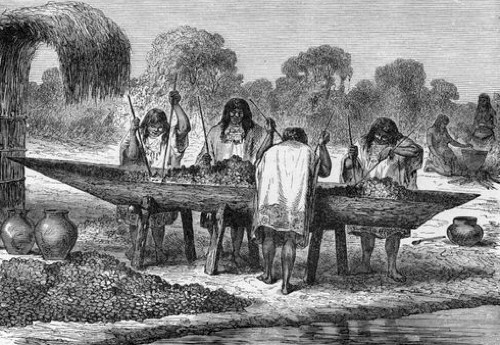
Above: Extracting oil from turtle eggs. “Several thousand persons occupy themselves in the season in preparing turtle oil on the banks of the Orinoco, Amazon, Negro, and other rivers of South America. … An acre of sand has been known to yield eggs sufficient to make 100 pots or jars of oil. The eggs when collected, are thrown into large troughs of water, and being broken and stirred with shovels, they remain exposed to the sun till the yolk, the oily part, is collected on the surface and has time to inspissate; as fast as the oily part rises it is skimmed off and boiled over a quick fire. This turtle grease or oil, when well prepared, is limpid, inodorous, and slightly yellow. It is used not merely to burn in lamps, but in dressing victuals, to which it imparts no disagreeable taste. … The total made on the three shores between the junction of the Orinoco and Apur, is said to be about 5,000 jars, and it takes about 5,000 eggs to make one jar of oil.” (Simmonds, 1863, p. 334)
When Europeans colonised areas where turtles were found, they began to be harvested on an industrial scale. Turtle eggs and the turtles themselves were converted into oil which could be used fresh as cooking oil or stored to be used to oil leather, as a lubricant, or burnt as a heating or lighting fuel (Simmonds, 1879, p. 368).
As well as collecting turtle eggs for oil, hawksbill turtles were killed for their shells – which were made into tortoiseshell combs, fans, boxes and other articles – and green turtles were hunted for their flesh, which was sent, fresh or canned, to be consumed on Western dining tables.
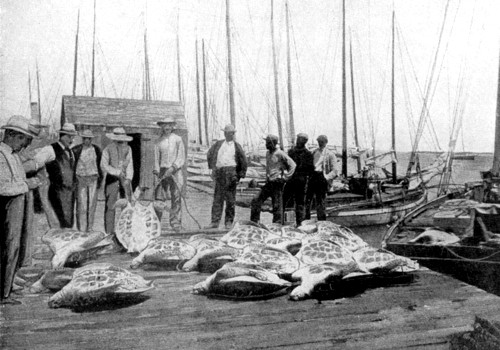
Above: c.1900 Captured sea turtles in Key West, Florida.
Turtle soup was such a popular dish in late nineteenth-century England that canneries were set up in the Americas to make and export it.
Green turtle soup is now manufactured in America and the West Indies. A manufactory at Key West, Florida, puts up in air-tight cans for exportation 200,000 Ibs. yearly, and employs 10 vessels and 60 men in collecting the turtle. It is sent to England and Cuba chiefly. At Jamaica some factories are also doing a good business in a preparation worthy of the gastronomic patronage of an aldermanic banquet, so rich is it in green fat and calipee, calipash, and those delicate gelatinous morsels appertaining to the fins. A steady supply of turtle is obtained monthly through the West India and Pacific steamers from Colon [Panama], besides those brought from the Caymanas. 5484 Ibs. of prepared turtle, valued at £356, were shipped from Jamaica in 1874.
(Simmonds, 1879, pp. 367-368)
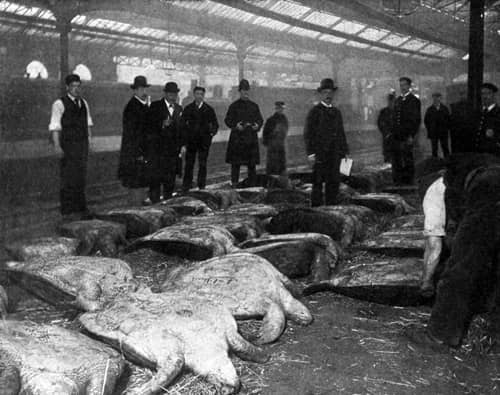
Above: c.1909 Imported turtles laid out in a London train station. Many would die during transportation.
Cosmetics
Cosmetics were another matter. There is evidence that turtle oil had been used for skin-care by the indigenous inhabitants of the Americas but it did not find its way into Western skin creams in any major way until the 1930s. The practice seems to have started in Europe and probably came out of the same German and French research into the use of animal serums and extracts – opotherapy/organotherapy – that led to the introduction of hormones and other tissue extracts in skin creams.
A foreign manufacturer advertised a turtle hormone cosmetic at a high price. This cosmetic was alleged to contain the active substance from the turtle skin and was said to be a rejuvenator. Almost immediately other manufacturers tried to copy the product with turtle oil as the active ingredient.
(deNavarre & Ruszkowski, 1933, p. 17)
See also: Hormone Creams, Oils and Serums and Placental Creams and Serums
The logic behind the use of turtle oil was something along the lines of: “Turtles live to a ripe old age. This is due to the oil in their bodies. Thus, If a cream containing turtle oil is smeared on the face, miraculous skin rejuvenation will result” (Hearings: US Congress, 1960). As well as having a long life, turtles were also thought to have exceptional powers of skin healing. Added to this were stories about native women who used turtle oil on their face being wrinkle free.
Extraction
Turtle oil could be crudely extracted by first heating turtle fat and other body parts in large kettles. The oil was then separated out and canned. However, more up-to-date operators used steam distillation to render the oil (deNavarre & Ruszkowski, 1933, p. 17). Turtles could be used specifically for this purpose but a lot of turtle oil was produced as a by-product of the canned turtle soup industry.

Above: In 1947, Moore and Co. Soups, Inc. of New York were using 5,000 Caribbean turtles annually to make 600,000 quarts of turtle soup. The caption to this picture reads: “In a crowded storage room cooks walk on turtles to select one. The turtles are put on their backs, with flippers trussed, to keep them quiet” (LIFE, 1947).
After the oil was extracted it would be refined and then stabilised to prevent it from going rancid. Many turtle oils were of a dark colour and had a strong odour, so the oil might also need deodorising and decolouring before it could be added to skin creams. One of the reasons why green sea turtles – Atlantic or Pacific – were the preferred source of cosmetic turtle oil was that the oil they produced was less odouriferous.
The oil from the green turtle bids fair to be the most desirable variety of turtle oil for cosmetic purposes. It is of a strong yellow color, is a solid between 15 and 20°C., it presents an individual but persistent odor, not particularly fishy when fresh, but developing a fishy odor on standing, particularly when exposed to the air.
The variation in the odor of the oils has been ascribed to the feeding habits of the various turtles—the green turtle is a strict vegetarian, while the loggerhead turtle is a scavenger.
Supplies of the oil from the green turtle, which oil is the least odorous are the scarcest. No estimate as to the quantity available, or as to the possibility of increasing that quantity, is available. At present the green turtle oil is a by-product from the canning of green turtle substance and the making of green turtle soup. a green turtle weighing about four hundred pounds weighs from fifteen to twenty-five pounds of oil.(Brown, 1933, p. 211)
Characteristics
Like other biological materials, the nature and quality of turtle oil varied considerably, depending on its source and how it was extracted and purified. This large variation in turtle oils made it difficult for cosmetic chemists of the time to analyse the properties of the oil and come to any specific conclusions about its properties and effectiveness. A lot of turtle oil was also adulterated, with shark oil being a common substitute.
Oil from the turtle has found rather recent use in the cosmetic industry in the U.S.A., probably more as a new line of publicity than on its actual merits. On the whole, however, it would seem to have undergone a rather unfair test, as it is very difficult to obtain unadulterated oil on the open market, and if this is obtained it is usually at such an exorbitant price that its use in creams to any considerable extent seems to be prohibited. Particularly this is so if a large and expensive amount of perfume must be used to hide the repellent odour of the crude oil.
(The Manufacturing Chemist, 1934)
The adulteration problem did not go away as the century progressed. A well-known advocate of turtle oil in the 1950s, Dr. Nadja Avalle, found that most samples of turtle oil she examined were grossly adulterated, some containing less than 10 per cent turtle oil (SPC, 1956).
Despite these problems, a number of assays of turtle oil were conducted in the 1930s. These concluded that turtle oils did NOT appear to contain any hormones, ‘youthifying agents’ or turtle skin extracts. Some included material taken from various turtle glands but any active ingredients they might have contained were inactivated by the heating and chemical processes involved in the extraction and refinement of the oil. For example, turtle oil contained vitamin A, but this was often removed when the oil was filtered through kaolin or charcoal to improve its colour and odour. By the middle of the 1930s most cosmetic chemists had come to the conclusion that there was nothing about the oil that would substantiate the considerable hype attributed to it; even its supposed astringent properties were questioned.
Turtle oil is claimed to be one of the most powerful “natural astringents” known. It is difficult to see how such a claim can be substantiated, as it possesses none of the properties which can be associated with “astringency”.
(Harry, 1944, p. 98)
Products
Despite the lack of hard evidence for their efficacy, turtle oils were incorporated into a wide range of cosmetics and toiletries in the 1930, including perfumes, soaps, face creams, cleansers, hand creams, eyelash growers and mascaras. Admittedly, most of the companies that used it were minors rather than the majors. Perhaps they hoped that turtle oil would help them break into the crowded cosmetics market in the more difficult years of the depression.
Most turtle oil creams made in the 1930s contained less than than 10 per cent of the oil with many creams being less than 5 per cent (deNavarre & Ruszkowski, 1933, p. 17). Two recipes for turtle oil creams are given below:
Diglycol stearate 11.6 g. Mineral oil, white 31.5 g. Lanolin 4.7 g. Water, distilled 49.75 g. Petrolatum, white 1.65 g. Turtle oil 0.5 g. Perfume 0.3 g. Emulsify at 75-78°C., perfume at 50°C., stir until cooled at 38°C.
If you wish to thin this down, add mineral oil.(Manufacturing Perfumer, 1937)
Turtle Oil (Pale Deodorized) 10 Diglycol Stearate 10 Liquid Paraffin 30 Lanolin Absorption Base 9 Perfume 1 Water (distilled) 40 Procedure:
Melt the fats and wax and stir in the hot Water at a temperature of 170°F. The Perfume is added with slow stirring when the batch has cooled to about 120°F., after which the stirring device may be switched off, and the batch allowed to cool.(Ash & Ash, 1977, p. 302)
Clearly, if the oil was to be of any value as a ‘skin nutrient‘, greater quantities than these would needed in a formulation.
Later uses
Although the turtle oil craze had faded well before the beginning of the Second World War, products containing it continued to be produced through to the 1970s.
Old horses like old generals just will not die. Now it is turtle oil, pretty well buried for almost 20 years, being touted by both French and Germans as an astringent oil, vitamin and hormone vehicle and ingredient without equal. Maybe it is. Seemed like it once. But vitamin assays on it showed nothing exciting and the oil itself is a comparatively unsaturated animal oil with “characteristic odor.” That presents problems.
(Navarre, 1956, p. 11)
Of all the products developed after the war, Estée Lauder’s cream of creams ‘Re-Nutriv’ introduced in 1957 is perhaps the most infamous. Containing turtle oil, shark oil and royal jelly in a 22-karat gold jar, it launched with a catchy advertising campaign asking “What makes a cream worth $115.00?”.
Rare ingredients. Rare formula. But above all, the rare perception of a woman like Estée Lauder who knows almost better than anyone how to keep looking younger, fresher, lovelier than you ever dreamed possible. She has created what she likes to think of as “a goldmine of beauty” – her Creme of Creams RE-NUTRIV.
This treasury of some of the world’s costliest ingredients includes Turtle Oil, Shark Oil, Royal Jelly, Silicone and Leichol, plus 20 additional ingredients never before blended into one jar of cream. This concentration of youthgiving agents helps rebuild and firm the skin, reflecting the freshness and radiance of a years-younger complexion.(Estée Lauder advertisement, 1959)
The name of the cream suggested that these ingredients were skin nutrients, thereby getting around any potential problems with United States regulatory authorities like the Federal Trade Commission (FTC) and the Food and Drug Administration (FDA). Despite the perception that the ingredients included in Re-Nutriv were rare and expensive, this was more fiction than fact.
Although Estée Lauder listed turtle oil, along with shark oil, as one of the world’s costliest rare ingredients, a check showed that the oils were available in sloshing quantities at prices that ranged from a penny to six cents per ounce. Their rarity can be measured by the nuisance-point abundance of turtles and sharks. Suppliers were eager to ship ready surpluses for any cream that would take it.
Like a star making a comeback, the turtle can swan its wrinkled neck back to the twenties and early thirties, when it was a thing of beauty to cosmetic manufacturers. Turtlers, glad to get rid of the smelly oil left over after soup-making and other turtle business had reason to admire the acumen of the cosmetic promotors able to make women accept the turtle-for-beauty campaign.(Stabile, 1969, pp. 98-99)
See also: Estée Lauder
Turtle Conservation
The work of conservationists like Archie Carr [1909-1987] were instrumental in drawing attention to the plight of the sea turtle.

Above: Archie Carr examining a sea turtle killed by poachers.
As the world became more ecologically conscious, the use of turtle oil and other animal products in skin creams became advertising poison and cosmetic companies switched to using plant extracts instead. Eventually, as countries around the world placed legislative bans on the importation and use of endangered species, it became impossible, even for turtle farms, to export turtle products to many countries.
Cosmetics that contained turtle oil were either discontinued or substituted the turtle oil with something else. For example, in response to criticism by conservationists and legislative bans in California, the Polly Bergen Company announced in 1975 that the natural turtle oil in its skin-care lines would be replaced with a new artificial lubricating emollient called ‘Replensil’.
Despite the ban on the use of turtle oil, there are still cosmetics labelled as ‘Turtle Oil’ or ‘Turtle Cream’ or ‘Creme de Tortuga’ on the market today. However, I doubt any are made with real turtle oil.
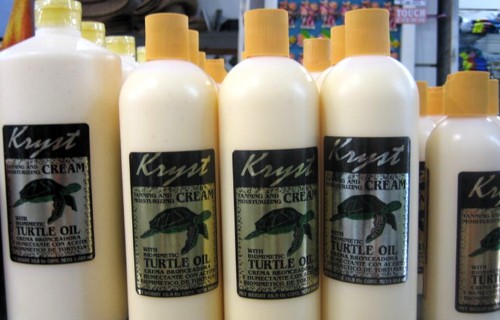
Above: Kryst Cream. Although the product prominently displays the phrase ‘Turtle Oil’ and a picture of a turtle, the label says ‘biomimetic turtle oil’ which means like, not actual, turtle oil.
A careful look at the ingredients list will help any purchaser make sure this is the case.
First Posted: 18th April 2013
Last Update: 3rd September 2024
Sources
Ash, M., & Ash, I. (1977). A formulary of cosmetic preparations. New York: Chemical Publishing Co. Inc.
Brown, F. W. (1933). Turtle oil facts. The Drug and Cosmetic Industry. 32(3), 211 & 230.
deNavarre, M. G., & Ruszkowski, S. (1933). Turtle oil. The American Perfumer & Essential Oil Review. March, 16-18.
deNavarre, M. G. (1956). Desiderata. The American Perfumer & Aromatics. November, 11-12.
Harry, R. G. (1944). Modern cosmeticology. (2nd ed.). London: Leonard Hill.
Hearings before the subcommittee of the committee on appropriations. House of representatives. Eight-sixth Congress, Second session. (1960). Washington: Government Printing Office.
The manufacturing chemist. (1934). London: Miller Freeman.
Manufacturing perfumer. (1937). London: Leonard Hill.
Turtle Soup. (1947). LIFE. March 10th, 121-127. New York: Time, Inc.
Simmonds, P. L. (1863). Oils and fats shown at the exhibition. The technologist. 3, 324-334. London: Kent & Co.
Simmonds, P. L. (1879). The commercial products of the sea; or, marine contributions to food, industry and art. London: Griffith and Farran.
Stabile, T. (1969). Cosmetics: Trick or treat? (3rd ed.). New York: Arco Publishing Company, Inc.
Thomssen, B. S. (1947). Modern cosmetics (3rd ed.). New York: Drug & Cosmetic Industry.
Soap, perfumery & cosmetics. (1956). August. London: London Trade Press Ltd.

The green sea turtle, the preferred source of turtle oil for use in cosmetics.
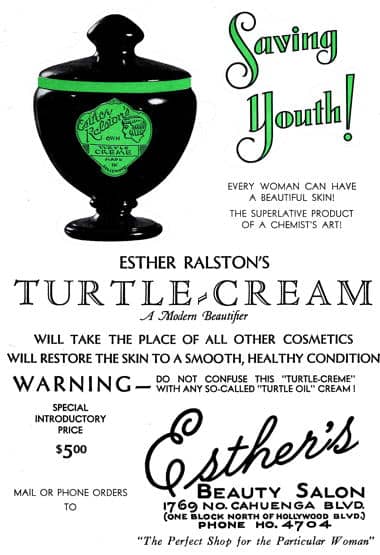
1931 Esther Ralston’s Turtle-Cream.
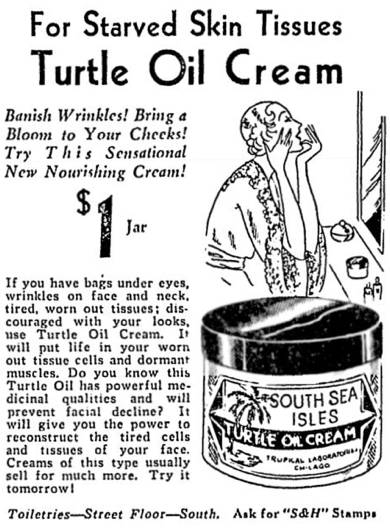
1932 South Sea Isles Turtle Oil Cream.
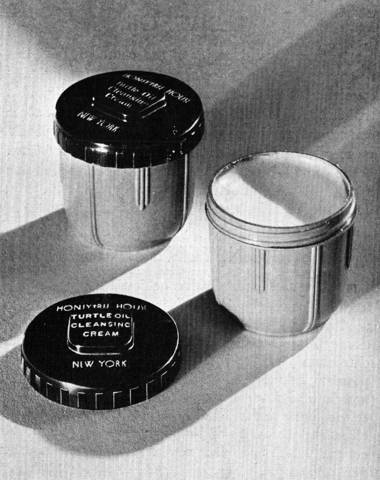
1933 Honeytree Turtle Oil Cleansing Cream.
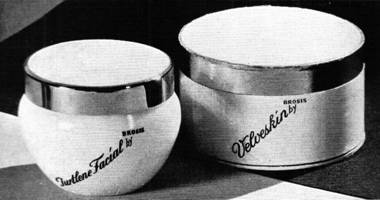
1933 Brosis Laboratories Turtlene Facial Cream and Velveskin Powder.
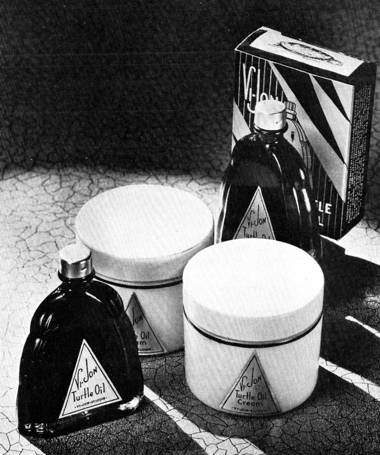
1934 Vi-Jon Turtle Oil and Turtle Oil Cream.
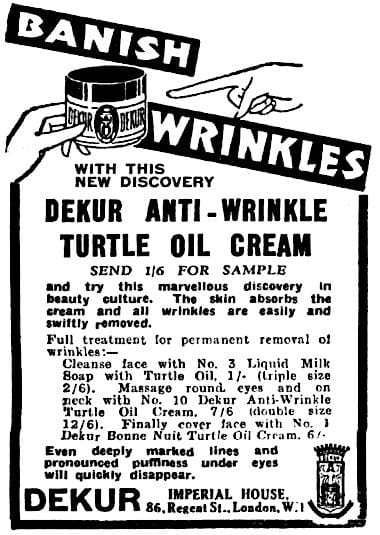
1934 Dekur Anti-Wrinkle Turtle Oil Cream.
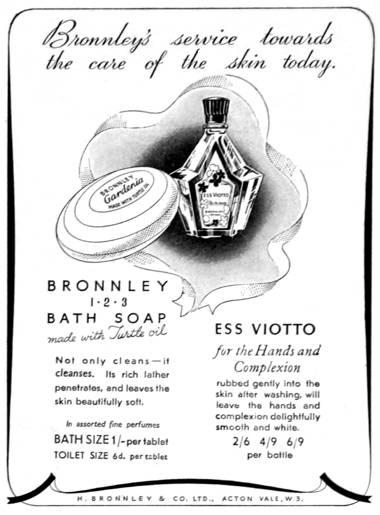
1936 Bronnley Soap with turtle oil.
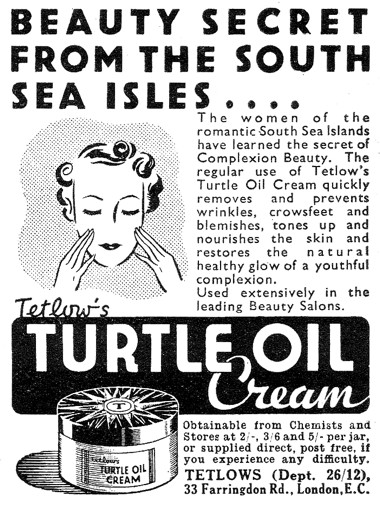
1939 Tetlow’s Turtle Oil Cream.

1939 Mason’s Green Turtle Oil products.
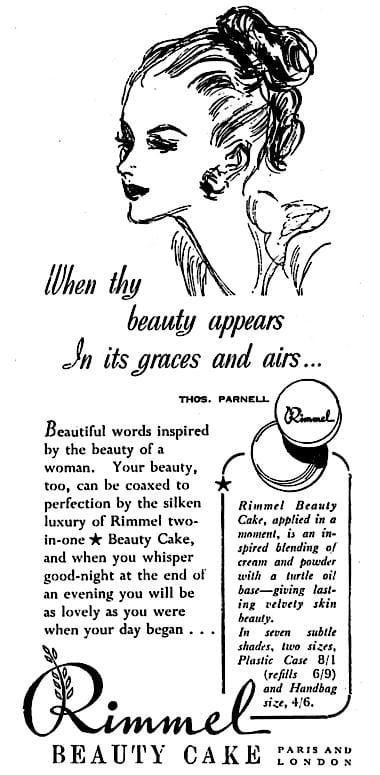
1947 Rimmel Beauty Cake with turtle oil.
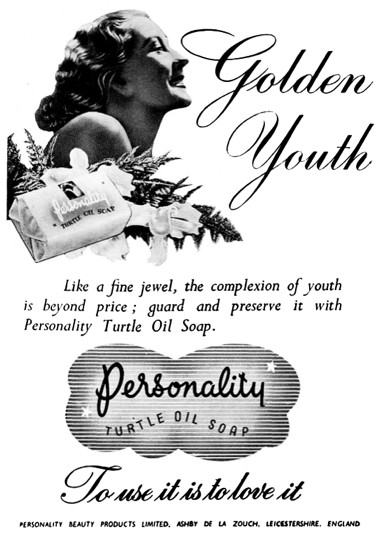
1951 Personality Turtle Oil Soap.
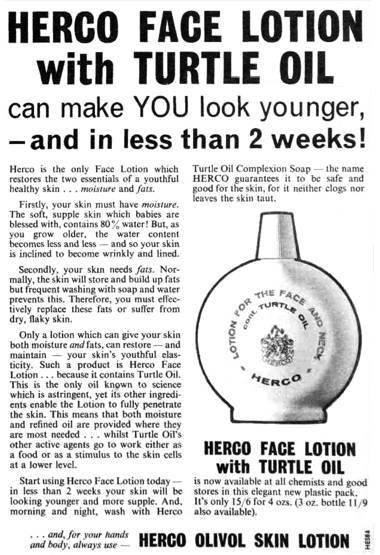
1956 Herco Face Lotion. The advertisement suggests that turtle oil works as a skin food, an astringent and as a stimulus to skin cells.
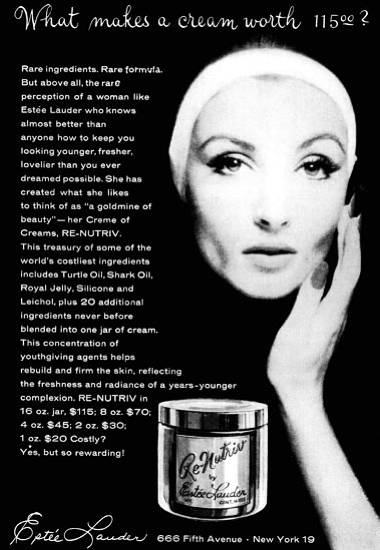
1959 Estée Lauder Re-Nutriv cream.
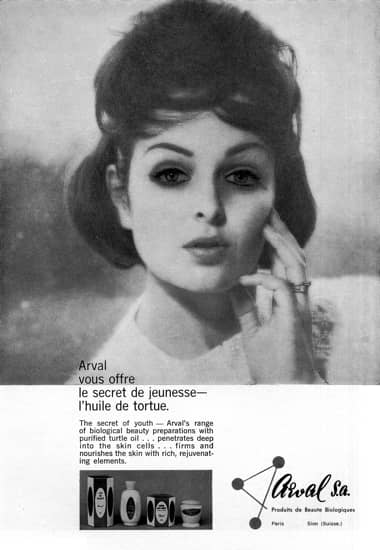
1964 Arval l’Huile de Tortue.
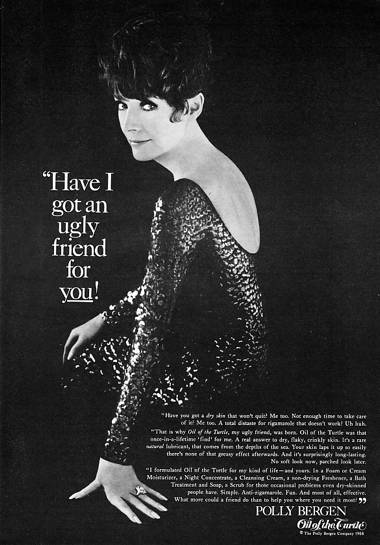
1968 Polly Berger Oil of the Turtle. The turtle oil in its product line was removed in 1975 by Paramount Pictures who acquired the company in 1971 after it had made large losses. They later sold it to Fabergé in 1973.
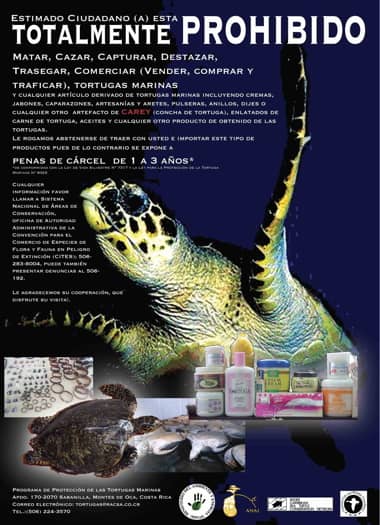
Sea turtle products trade prohibition poster.

1975 Arval Crème à l’Huile de Vison (Mink Oil Creme), Crème à l’Huile de Tortue (Turtle Oil Creme) and extrait placentaire (Placental Extract). Arval still make an anti-wrinkle cream labelled ‘Traditionelle Tortue’ but it seems to be made with avocado, not turtle oil.
